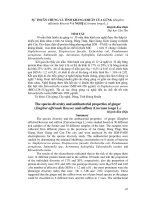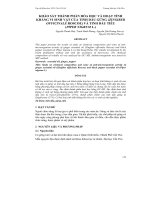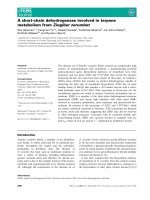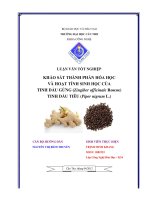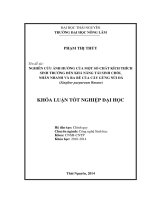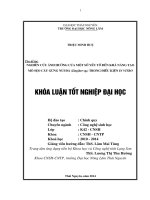Zingiber locbacense
Bạn đang xem bản rút gọn của tài liệu. Xem và tải ngay bản đầy đủ của tài liệu tại đây (6.32 MB, 9 trang )
<span class="text_page_counter">Trang 1</span><div class="page_container" data-page="1">
<b>Zingiber locbacense (Zingiberaceae), a New Speciesfrom Lam Dong Province, Southern Vietnam</b>
Authors: Nguyễn, Danh Đức, and Lin, Che-WeiSource: Annales Botanici Fennici, 61(1) : 123-130
Published By: Finnish Zoological and Botanical Publishing BoardURL: Complete (complete.BioOne.org) is a full-text database of 200 subscribed and open-access titlesin the biological, ecological, and environmental sciences published by nonprofit societies, associations,museums, institutions, and presses.</small>
<small>Your use of this PDF, the BioOne Complete website, and all posted and associated content indicates youracceptance of BioOne’s Terms of Use, available at www.bioone.org/terms-of-use.</small>
<small>Usage of BioOne Complete content is strictly limited to personal, educational, and non - commercial use.Commercial inquiries or rights and permissions requests should be directed to the individual publisher ascopyright holder.</small>
<small>BioOne sees sustainable scholarly publishing as an inherently collaborative enterprise connecting authors, nonprofitpublishers, academic institutions, research libraries, and research funders in the common goal of maximizing access tocritical research.</small>
</div><span class="text_page_counter">Trang 2</span><div class="page_container" data-page="2">Helsinki 6 May 2024 © Finnish Zoological and Botanical Publishing Board
<i>Zingiber locbacense (Zingiberaceae), a new species </i>
from Lam Dong Province, southern Vietnam Danh ĐứcNguyễn<small>1,</small>* & Che-Wei Lin
<small>2</small>
<small>1)</small><i><small> Institute of Applied Technology, Thu Dau Mot University, no. 06, Tran Van On Street, Phu Hoa </small></i>
<i><small>Ward, Thu Dau Mot City, Binh Duong Province, Vietnam (*corresponding author’s e-mail: )</small></i>
<small>2)</small><i><small> Herbarium of Taiwan Forestry Research Institute, Taiwan Forestry Research Institute, No. 53, </small></i>
<i><small>Nan-Hai Road, Taipei 100, Taiwan</small></i>
<i><small>Received 23 Jan. 2024, final version received 19 Apr. 2024, accepted 19 Apr. 2024</small></i>
<i><small>Nguyễn D.D. & Lin C.W. 2024: Zingiber locbacense (Zingiberaceae), a new species from Lam Dong Province, southern Vietnam. — Ann. Bot. Fennici 61: 123–130.</small></i>
<i>Zingiber locbacense D.D. Nguyễn & C.W. Lin sp. nova (Zingiberaceae) is described </i>
and illustrated from southern Lam Dong Province, south Vietnam. It is
<i>morpho-logically similar to Z. collinsii in several characters, from which it differs by having </i>
inflorescences with pink bracts and a rounded apex, shorter bracteoles, smaller corolla lobes, and the flowering period that occurs from March to early May. All known occur-
<i>rences of Z. locbacense are in non-protected areas, and there is a hydroelectric power </i>
station being developed in a neighbouring area. Hence we assess the conservational
<i>status of Z. locbacense as Endangered (EN).</i>
<i>Zingiber is one of the largest genera of </i>
Zingiber-aceae, with 210 accepted species ence.kew.org/results?f=species_f%2Caccepted_names&q=Zingiber). It is native to tropical and
<i>(-subtropical Asia. Species of Zingiber are </i>
charac-terized specifically by a pulvinus-like structure in the petiole and an elongated, beak-shaped anther appendix. This distinct-shaped anther appendix
<i>is also typical of the genus Cornukaempferia, </i>
endemic to Thailand, which however differs
<i>from Zingiber by having a reduced leafy shoot, </i>
composed of a few broad leaves only Škornicková & Newman 2015).
<i>(Leong-There are approximately 40 Zingiber species </i>
in Vietnam, of which many are narrow endemics
<i>(Lý et al. 2021). Recent field trips and specimen </i>
examinations resulted in the discovery of 13 new
<i>species from Vietnam (Leong-Skornicková et al. 2015, Lý 2016, Lê et al. 2019, Lý et al. 2021) </i>
<i>and two from Laos (Leong-Škorničková et al. </i>
2014, Newman 2015). Vietnam is identified as the diversity hotspot for the genus.
Lam Dong Province is located in southern Vietnam within the southern Annamite Range. Its northern part is a high-altitude mountain area comprising Lam Vien Plateau (average eleva-tion 1500 m a.s.l.) and Di Linh Plateau (average elevation 1000 m a.s.l.). Several new species of Zingiberaceae were recently described from the
<i>area (Lý et al. 2010, Lamxay & Newman 2012, Šída et al. 2019, Tagane et al. 2020). During our </i>
field studies in southern Lam Dong Province focused on extremely steep hills and valleys at 200–700 m a.s.l., located on the border of the southern Di Linh Plateau and north of Cat Tien National Park, we found peculiar specimens of
<i>Zingiber sect. Zingiber in Bao Lam District. </i>
A careful study of flowering plants collected
</div><span class="text_page_counter">Trang 3</span><div class="page_container" data-page="3"><small>124 </small> <i><small>Nguyễn & Lin: Zingiber locbacense, a new species from southern Vietnam • ANN. BOT. FENNICI Vol. 61</small></i>
from the field (between 2021 and 2023) and in cultivation, together with a detailed compari-son with herbarium specimens and the literature cited above, confirmed that our collections repre-sented an undescribed species.
The herbarium acronyms are according to
<i>Index Herbariorum ( locbacense D.D. Nguyễn & C.W. </b></i>
<i>Lin, sp. nova (Figs. 1 and 2)</i>
<small>Type: Vietnam. Lam Dong Province, Bao Lam District, Loc Bac Commune, ca. 300 m a.s.l., 11°47´11.5´´N, </small>
<i><small>107°33´13.3´´E, 1 May 2021 Nguyễn Danh Đức NDD 442, </small></i>
<small>both fruiting and flowering samples (holotype VNMN). — paraTypes: Vietnam. Lam Dong Province, Bao Loc City, Dambri Commune, Dambri waterfall, 700 m a.s.l., </small>
<i><small>11°38´30.3´´N 107°44´32.4´´E, 1 May 2021 Nguyễn Danh </small></i>
<i><small>Đức 281, fruiting samples (VNMN); Lam Dong Province, </small></i>
<small>Da Teh Dis., Trieu Hai Com., Trieu Hai waterfall, 300 m </small>
<i><small>a.s.l., 27 March 2023 Nguyễn Danh Đức 23012, flowering samples (LE).</small></i>
<small>eTymology</small><i><small>: The specific epithet refers to the Loc Bac </small></i>
<small>area, where the type material was discovered.</small>
Rhizomatous herb up to 1.7 m tall, ing small clumps, with up to 6 leaf shoots per clump. Rhizome branched, 1–3.3 cm in diam., 0.8–2.3 cm between leafy shoots arising from same rhizome, externally pale yellow (young rhizomes) to brown (older rhizomes), internally pale brown tinged purple, aromatic, covered with light brown triangular scales, 2.5–3.2 cm
<i>form-long, glabrous, quickly decaying. Leafy shoots </i>
arching, composed of 17–20 leaves with blades aggregated on upper 3/4 of pseudostem, basal 1/4 enclosed in bladeless sheaths, base swollen to 2 cm in diameter; bladeless sheaths 6–8, 2.8–20.8 cm long, dark green or faint dark purple-green tinge, lower ones red-brown or red, externally sparsely pubescent, internally glabrous; leaf sheaths green to dark purplish-green, glabrescent at base, sparsely pubescent towards petiole; ligules entire or emaginate, 0.8–1.8 cm long, translucent white, soon decayed, white pubescent, apex rounded. Petiole short 5–7 mm, consisting of light green pulvinus only, white pubescent, pale green, tinged red in young leafy shoot becoming pale green with age; margin translucent, soon decayed; lamina
leaf-elliptic-oblong, 18–25 × 6–7 cm, slightly cate; adaxially green, glossy and glabrous; abax-ially light green and white pubescent through-
<i>pli-out, base obtuse, apex attenuate. Inflorescence </i>
arising directly from rhizome near base 1-year leafy shoots, 27–35 cm long, with 1 or 2 flow-ers opening at a time in morning; peduncle radical, erect, 14–18 × ca. 0.7 cm, covered by 5–7 sheathing bracts, broadly triangular, 4–5 × 1.4 cm (smaller towards base), pale pink, out-side sparsely pubescent; spike 14–17 × 3–4 cm, fusiform to ovoid, consisting of 32–50 fertile bracts; bracts enclosing single flower, oblong to obovate-oblong, 2.5–3 × 1.6–2.1 cm (smaller towards apex), outside pale pink, turning white at apex and base, glabrous, inside paler, gla-brous, margins translucent, apex obtuse or rounded; bracteole tubular, 2–2.2 cm long, semi-translucent, white, abaxially sparsely pubescent throughout, apex acute, sometimes short bifid. Flower exerted from bract to 5 cm long; calyx tubular, ca. 1.4 cm long, translucent white, gla-
<i>brous, with unilateral incision ca. 4 mm, apex entire; corolla tube ca. 3.7 cm long, widening </i>
gradually towards apex, white at base, creamy yellow towards apical part, abaxially glabrous, adaxially sparsely puberulent at apex; corolla lobes, dorsal triangular-ovate, 15–16 × 5–6 mm, light creamy yellow with semi-translucent veins, glabrous, apex slightly mucronate, with a short mucro less than 1 mm long; lateral corolla lobes narrowly ovate, 14–15 × ca. 4 mm, light creamy yellow with semi-translucent veins, glabrous, apex acute; labellum obovate, 15 × 11 mm, slightly concave above throat, flattening towards apex, creamy yellow, mottled with purple dots at apex-half, apex rounded and slightly emarginate at tip; lateral staminodes 11 × 2.5 mm, oblong, white cream, 1/3 length at base connected to
<i>labellum, apex rounded. Stamen ca. 12 mm long; </i>
filament 1–1.5 mm long by ca. 1.3 mm broad, creamy yellow, glabrous; anther 10–10.5 × ca. 3 mm (crest not straightened), connective tissue creamy yellow, glandular hairs; anther thecae 10–10.5 mm long, dehiscing by longitudinal slits; anther crest hook-shaped 4–6 mm long (straightened), wrapped around stigma, creamy white, tinged various degree of purple apically,
<i>glabrous. Style to 85 mm long (straightened), </i>
white with reddish tinge towards apex; stigma
</div><span class="text_page_counter">Trang 4</span><div class="page_container" data-page="4"><i><b><small>Fig. 1. Zingiber locbacense (from the holotype). — A: Habit. — B: Ligule. — C: Inflorescence. — D: Flower, frontal </small></b></i>
<b><small>view. — E: Labellum with basally connate lateral staminodes. — F: Dorsal corolla lobe. — G: Lateral corolla lobes. — H: Calyx. — I: Bracteole. — J: Bract. — K1–3: Anther, side, back and frontal views. — L: Ovary with two epigy-</small></b>
<small>nous glands.</small>
</div><span class="text_page_counter">Trang 5</span><div class="page_container" data-page="5"><small>126 </small> <i><small>Nguyễn & Lin: Zingiber locbacense, a new species from southern Vietnam • ANN. BOT. FENNICI Vol. 61</small></i>
<i><b><small>Fig. 2. Zingiber locbacense. — A: Habit and habitat (type locality, 1 May 2021). — B: Habit with inflorescence </small></b></i>
<b><small>in-situ. — C: Ligule. — D and E: Leaf, upper and lower surface views. — F: Inflorescence at peak flowering season with opening flowers in front and side view. — G and H: Flower, front and top views. — I: Bract. — J: Bracteole. — K: Calyx. — L: Dorsal corolla lobe. — M: Lateral corolla lobes. — N: Labellum with basally connate lateral sta-minodes. — O: Ovary, flower tube and anther, side views. — P: Anther, side, back and frontal views, the ovary with two epigynous glands. — Q: Immature fruit.</small></b>
</div><span class="text_page_counter">Trang 6</span><div class="page_container" data-page="6">2–3 × ca. 0.4 mm, white, ostiole front facing downwards, with a ring of straight ciliates. Epig-
<i>ynous glands 2, subulate, ca. 5 × 0.5 mm diam., </i>
cream yellow. Ovary 3–5 mm long, cylindrical, white, sparsely pubescent, trilocular with central placentation. Immature fruit trilocular, obloid or ovoid, 16–18 × 8–11 mm, white, glabrous. Flowering in March to early May, fruiting in May to July.
D<small>isTribuTionanDhabiTaT</small><i>. Zingiber </i>
<i>locba-cense is known only from the Loc Bac area in </i>
southern Lam Dong Province, southern Vietnam. It grows on deeply shaded slopes or granite cliff faces, on soil pockets in evergreen broadleaf or mixed (broadleaf and bamboo) forests near streams at 200–900 m a.s.l.
C<small>onservaTionassessmenT</small>. We found two
<i>small groups of Z. locbacense comprising only </i>
10 adult plants in total, on steep banks of two springs flowing into the Dong Nai River. We also found many plants without flowers throughout the southern Lam Dong Province at 200 to 900 m a.s.l., with vegetative characteristics resembling
<i>those of Z. locbacense. Thus, we estimate that </i>
in total there could be about 100 individuals in Lam Dong Province, all in non-protected area. The species may be threatened by the paucity of fertile individuals, and because of habitat change caused by the nearby hydroelectric power sta-tion. Deforestation is destroying the wet, humid habitat of this species. The extent of occurrence (EOO) is estimated to be 4000 km<small>2</small> and the area of occupancy (AOO) about 100 km<small>2</small>. Therefore, following the IUCN criteria ( we assessed its conservation status as Endangered (EN: B1 ab(iii)).
Based on the inflorescence composed of a
<i>spike on an upright peduncle, we place Z. </i>
<i>locba-cense in the sect. Zingiber. It is the largest </i>
sec-tion of this genus, and its species are distributed in various habitats throughout southern China and south to southeastern Asia. The phylogenetic
<i>analysis by Theerakulpisut et al. 2012) divided </i>
the section into two distinct geographical groups: one in the monsoonal Asian continent, and the second in the evergreen Malesian area.
<i>The vegetative characters of Z. locbacense resemble those of Z. collinsii (Appendix 1A and B), Z. montanum (Appendix 1C and D) and Z. </i>
<i>eberhardtii (Appendix 2), but there are several </i>
differences among the species (Appendix 3).
<small>speCimensexamineD</small><i><b><small>. — Zingiber eberhardtii: Vietnam. </small></b></i>
<i><small>Unspecified location, J. Mood 94P19 (AAU); cultivated </small></i>
<small>at Royal Botanic Garden Edinburgh under acc. number </small>
<i><small>19901477, M. Newman & J. Škorničková 2035 (E00294301, </small></i>
<small>E00294302, E00319374), original collection from Lam Dong </small>
<i><small>Province, M. Newman L10 (E199014773), M. Newman 2022 (E00328354, E00348117), Nguyễn Danh Đức 266, 497 (LE). </small></i>
<i><b><small>— Z. collinsii: Vietnam. Dak Lak Province, M. Collins VN80 </small></b></i>
<i><small>(holotype, AAU); Dak Nông Province, Trần Hữu Đăng </small></i>
<i><small>Tran-159 (E00428062, E00428063); Binh Phuoc Province, M.S. Nuraliev 884 (MW0749985); Binh Thuan Province, Nguyễn </small></i>
<i><b><small>Danh Đức 229 (LE). Laos. Attapeu Province, Souladeth </small></b></i>
<i><small>et al. L3151 (FOF, KAG, TNS), Tanaka L3151-R (FOF, </small></i>
<i><b><small>TNS). — Z. montanum: Thailand. Phuket Province, L. Bai, </small></b></i>
<i><small>B. Harwood & B.R. Maslin BLK075 (neotype BKF barcode </small></i>
<small>SN214984; isoneotypes C, KUN1345416); Ranong </small>
<i><small>Prov-ince, R. Geesink & T. Santisuk 4964 (lectotype of Z. </small></i>
<i><small>peninsu-lare, L0444287 image; isolectotypes BKF56751, L0444286 </small></i>
<i><b><small>image. China. Guangxi Province, D.H. Qin & R.Z. Huang </small></b></i>
<i><b><small>36982 (holotype of Z. nudicarpum, GXMI051071). Laos. </small></b></i>
<i><small>Attapeu Province, M. Newman 2442 (cultivated at RBGE, originally from Lamxay et al. VL1967, E); Houaphan Prov-ince, J. Leong-Škorničková et al. JLS-2386 (E, QBG, SING, </small></i>
<small>living collection at Pha Tad Ke Botanical Garden); </small>
<i><small>Kham-moune Province, L.V. Averyanov et al. AL878 (LE01049231). </small></i>
<i><b><small>Vietnam. Nghệ An Province, Đỗ Ngọc Đài 263 (FAFF); Pù </small></b></i>
<i><small>Hoạt NR, Đỗ Ngọc Đài 540 (FAFF), Nguyễn Danh Hùng 471 (FAFF); Quảng Bình Province, Đỗ Ngọc Đài 271 (FAFF); Quảng Nam Province, Đỗ Ngọc Đài 196 (FAFF); Quảng Ngãi Province, Lý Ngọc Sâm 635, 637 (VNM); Thừa Thiên Huế Province, Đỗ Ngọc Đài 4040, 4520, 4527 (FAFF); Lam Dong Province, Nguyễn Danh Đức 297 (LE).</small></i>
<small>The authors are grateful to Chi-Hung Lee for improving the language. The first author sincerely thanks Timothy Chap-man, the owner of Gingerwood Nursery Newsletter, and his father, Dr. Russell L. Chapman from Louisiana State Univer-sity’s College of the Coast and Environment (US), for their support in improving the language of the last manuscript revision. We also thank Dr. Avelinah Binti Julius, who served as a reviewer, for his valuable comments and constructive feedback. The authors are grateful to Dr. Quang Cường Trương, a researcher from Bidoup-Nui Ba National Park, for </small>
<i><small>sharing photos of Z. eberhardtii.</small></i>
</div><span class="text_page_counter">Trang 7</span><div class="page_container" data-page="7"><small>128 </small> <i><small>Nguyễn & Lin: Zingiber locbacense, a new species from southern Vietnam • ANN. BOT. FENNICI Vol. 61</small></i>
<i><small>Lamxay V. & Newman M. 2012: A revision of Amomum </small></i>
<small>(Zingiberaceae) in Cambodia, Laos and Vietnam. — </small>
<i><small>Edinburgh Journal of Botany 69: 99–206.</small></i>
<small>Lê T.H., Trinh T.H, Đỗ N.Đ., Nguyễn V.H. & Lý N.S. 2019: </small>
<i><small>Zingiber vuquangense (Sect. Cryptanthium: </small></i>
<small>Zingiber-aceae): a new species from North central coast region, </small>
<i><small>Vietnam. — Phytotaxa 388: 295–300.</small></i>
<i><small>Leong-Škorničková J. & Newman M.F. 2015: Gingers of </small></i>
<i><small>Cambodia, Laos and Vietnam. — Royal Botanic Garden, </small></i>
<small>Leong-Skornicková J., Nguyễn Q.B., Trần H.Đ., Šída O., </small>
<i><small>Rybková R. & Trương B.V. 2015: Nine new Zingiber species (Zingiberaceae) from Vietnam. — Phytotaxa </small></i>
<small>Lý N.S., Do D.G., Cao N.G., Truong B.V., Nguyen V.T. & </small>
<i><small>Leong-Skornicková J. 2021: Zingiber magang and Z. </small></i>
<i><small>tamii (Zingiberaceae), two new species from central </small></i>
<i><b><small>Appendix 1. — A and B: Zingiber collinsii (Binh Thuan Province, Vietnam), from Nguyễn Danh Đức 229 (LE). — C </small></b></i>
<i><b><small>and D: Z. montanum (Lam Dong Province, Vietnam), from Nguyễn Danh Đức 297 (LE).</small></b></i>
<i><small>Vietnam. — Taiwania 66: 232–240. </small></i>
<i><small>Lý N.S., Hul S. & Leong-Škorničková J. 2010: </small></i>
<i><small>Siliquamo-mum oreodoxa (Zingiberaceae): a new species from </small></i>
<i><small>Southern Vietnam. — Gardens’ Bulletin Singapore 61: </small></i>
<i><small>2019: Meistera caudata and Meistera sudae </small></i>
<small>(Zingiber-aceae: Alpinieae), two new ginger species from </small>
<i><small>Bidoup-Núi Bà National Park, southern Vietnam. — Phytotaxa </small></i>
<small>419: 221–231.</small>
<small>Tagane S., Nguyen V.N., Hoang T.B., Nagahama A., Zhang M., Truong Q.C., Le V.S., Dang V.S., Toyama H., Komada N., Nagamasu H. & Yahara T. 2020: Fif-teen new species of angiosperms from Bidoup-Nui BaNational Park, southern highlands of Vietnam. — </small>
<i><small>Acta Phytotaxonomica et Geobotanica 71: 201–229.</small></i>
<small>Theerakulpisut P., Triboun P., Mahakham W., Maensiri D., Khampila J. & Chantharanothai P. 2012: Phylogeny of </small>
<i><small>the genus Zingiber (Zingiberaceae) based on nuclear ITS sequence data. — Kew Bulletin 67: 1–7.</small></i>
</div><span class="text_page_counter">Trang 8</span><div class="page_container" data-page="8"><i><b><small>Appendix 2. Zingiber eberhardtii (from the type locality, Langbiang Plateau; cf. Gagnepain 1907). — A: Ligule. — </small></b></i>
<b><small>B–E: Inflorescences with opening flowers (D and E photo by Quang Cường Trương). — F: Flowering plant.</small></b>
</div><span class="text_page_counter">Trang 9</span><div class="page_container" data-page="9"><small>130 </small> <i><small>Nguyễn & Lin: Zingiber locbacense, a new species from southern Vietnam • ANN. BOT. FENNICI Vol. 61</small></i>
<i><b><small>Appendix 3. Morphological comparison of Zingiber locbacense, Z. collinsii, Z. eberhardtii and Z. montanum (data </small></b></i>
<i><small>on the three latter species based on our own observations, see Specimens examined).</small></i>
<i><small>Z. locbacense Z. collinsii Z. eberhardtii Z. montanum</small></i>
<small>Plant size (m) < 1.7 < 1.3 < 2 < 2.8Ligule</small>
<small>purple or brown tinged</small>
<small>reddish-Apex shape round acute to obtuse rounded obtuse to acute (sometimes</small>
<small>rounded at baseof spike)Bracteole length (mm) 20–22 35–40 ca. 26 32–35Calyx length (mm) 14 15–16 12–16 35–38Floral tube length (cm) 3.7 3.8 ca. 2.6 4.5–5.7Dorsal corolla</small>
<small> lobe size (mm) 15–16 × 5–6 23–25 × 10–12 27 × 10 35–41× 12–14Lateral corolla</small>
<small> lobe size (mm) 14–15 × 3.5–4.5 18–20 × 5–6 ca. 23 × 4 26–32 × 7–10Labellum</small>
<small> shape elliptic to obovate, triangular, triangular-ovate, triangular-ovate,apex rounded, flat apex acute and apex oblong or apex acute</small>
<small>undulate with tip rounded, concavepointing down</small>
<small> colour creamy yellow, creamy yellow, apical dull purplish-red, creamy white,apical half mottled half mottled with mottled with mottled withwith purple dots purple dots sparsely paler dots dense purplish-red</small>
<small>stripes and dots size (mm) 15 × 11 20 × 10 ca. 22–24 × 14–16 30–35 × 20–24Anther crest</small>
<small> length (mm) 4–6 15 ca. 13 14–17</small>
</div>